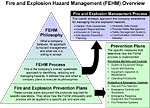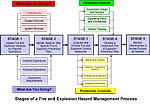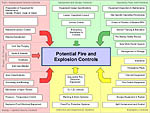Preventive Strategies & Controls |
 |

 Click on thumbnail for printable diagram Click on thumbnail for printable diagram
There are three primary elements in an effective approach to fire and explosion
hazard management - philosophy, strategy, and prevention plans and controls. The
philosophy reflects the company's approach to hazard management and the level of
risk it is willing to accept. The strategy defines the process that will be used
to identify, reduce and manage fire and explosion hazards. The prevention plans
document the specific control measures that will be used to implement the
strategy. The FEHM overview illustrates these concepts.

 Click on thumbnail for printable diagram Click on thumbnail for printable diagram
As this diagram illustrates, a fire and explosion management process needs to include the following stages:
| Stage 1: |
Assess Fire & Explosion Hazards for Planned Operations |
| Stage 2: |
Identify Need for Site-Specific Fire & Explosion Prevention Plan |
| Stage 3: |
Evaluate and Choose Fire & Explosion Control Measures |
| Stage 4: |
Develop & Implement Fire & Explosion Prevention Plan |
| Stage 5: |
Monitor Effectiveness and Revise Process as Needed |

 Click on thumbnail for printable diagram Click on thumbnail for printable diagram
This diagram provides a list of potential controls that should be considered to eliminate or reduce the risk of fires and explosions.
- Fuel-Hydrocarbon Source Controls
- Oxygen-Air Source Controls
- Energy-Ignition Source Controls
- Equipment and Design Controls
- Detection and Suppression Systems
- Operating Plans and Practices
- Emergency Controls
Related Information:
Preventive Strategies & Controls
FEHM Strategies | Operational Assessment Guidelines | Operational Controls
|



